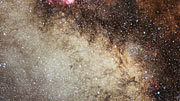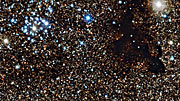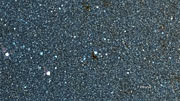Lehdistötiedote
"Pisara mustetta valoisalla taivaalla"
Wide Field Imager nappasi kosmisen gekon
13. helmikuuta 2013
Tämä ESO:n Chilessä sijatsevan La Sillan observatorion MPG/ESO 2.2-metrin teleskoopin Wide Field Imager -havaintolaitteella otettu kuva esittää kirkasta tähtijoukkoa NGC 6520 ja sen naapuria — outoa, gekonmuotoista pimeää pilveä Barnard 86. Tämän kosmisen parin taustana ovat Linnunradan kirkkaimman kohdan miljoonat loistavat tähdet. Kyseessä on alue, joka on niin täynnä tähtiä, että tuskin lainkaan pimeää taivasta näkyy tässä kuvassa.
Tämä Jousimiehen tähdistön (Sagittarius) osa on yksi koko taivaan runsaimmista tähtikentistä — Suuri Jousimiehen tähtipilvi. Tätä aluetta valaisevien tähtien valtava lukumäärä korostaa dramaattisesti ESO:n Chilessä sijaitsevan La Sillan observatorion MPG/ESO 2.2-metrin teleskoopin Wide Field Imager -havaintolaitteella otetun kuvan keskellä näkyvän Barnard 86:n kaltaisten tummien pilvien pimeyttä.
Tämän, nimellä Bokin globuli [1] tunnetun pienen, eristäytyneen tumman pilven löytäjä, Edward Emerson Barnard kutsui sitä "pisaraksi mustetta valoisalla taivaalla" [2]. Barnard oli yhdysvaltalainen tähtitieteilijä, joka löysi ja valokuvasi lukuisia komeettoja, pimeitä kaasusumuja, yhden Jupiterin kuista ja paljon muutakin. Hän oli poikkeuksellinen havaintojen tekijä ja innokas tähtivalokuvaaja sekä ensimmäinen, joka käytti hyvin pitkiä valotuksia kuvatakseen pimeitä sumuja.
Pienellä teleskoopilla Barnard 86 näyttää tähtien puutokselta, tai ikkunalta laikkuun etäistä, tyhjempää taivasta. Tämä kohde on kuitenkin todellisuudessa tähtikentän etualalla. Se on kylmä, pimeä ja tiheä pilvi, joka koostuu pienistä tähtien valoa peittävistä tomuhiukkasista ja saa alueen näyttämään läpinäkymättömältä. Sen ajatellaan muodostuneen kuvassa Barnard 86:n vasemmalla puolella näkyvän, läheisen tähtijoukon NGC 6520 syntyessä tiivistyneen molekulaarisen pilven jäänteistä.
NGC 6520 on avoin tähtijoukko, joka sisältää monia kuumia tähtiä, jotka loistavat kirkasta sinivalkoista valoa, mikä paljastaa niiden nuoruuden. Avoimet tähtijoukot käsittävät normaalisti joitakin tuhansia samaan aikaan muodostuneita tähtiä, jotka ovat siten samanikäisiä. Tällaiset tähtijoukot elävät normaalisti suhteellisen lyhyen aikaa, joitakin satoja miljoonia vuosia, ennen kuin niiden tähdet ajelehtivat hajalleen.
Tämän taivaanalueen uskomaton määrä tähtiä sotkee tähtijoukosta tehdyt havainnot, mistä syystä sitä on vaikea tutkia. NGC 6520:n ajatellaan olevan noin 150 miljoonaa vuotta vanhan ja sekä tämän tähtijoukon että sen tomuisen naapurin ajatellaan olevan noin 6000 valovuoden etäisyydellä Auringostamme.
Yllä olevassa Barnard 86:a esittävässä kuvassa näkyvät tähdet ovat itse asiassa pilven etualalla, meidän ja tumman pilven välissä. Vaikkakaan ei ole varmaa tapahtuuko niin yhä Barnard 86:ssa, useiden pimeiden sumujen keskustoissa tiedetään muodostuvan uusia tähtiä — kuten näkyy kuuluisassa Hevosenpääsumussa (eso0202), hätkähdyttävässä kohteessa Lupus 3 (eso1303) ja vähäisemmässä määrin toisessa Barnardin löydössä, Piippusumussa (eso1233). Nuorimmista tähdistä tulevan valon näkymisen estää kuitenkin niitä ympäröivän pilven tomu ja ne voidaan nähdä vain infrapuna- tai pitempien aallonpituuksien valossa.
Lisähuomiot
[1] Bokin globulit havaitsi ensimmäisenä tähtitieteilijä Bart Bok 1940-luvulla. Ne ovat hyvin kylmiä ja pimeitä kaasun ja tomun pilviä, joiden keskustoissa usein muodostuu uusia tähtiä. Näissä globuleissa on paljon taustan valoa hajoittavaa ja absorboivaa tomua, joten ne näyttävät lähes läpinäkymättömiltä näkyvässä valossa.
[2] Tämän lainauksen lähde on E. E. Barnard, Dark Regions in the Sky Suggesting an Obscuration of Light, Yerkes Observatory, 15.11.1913 (julkaistu verkossa täällä).
Lisätietoa
ESO on Euroopan johtava hallitustenvälinen tähtitieteen organisaatio ja maailman tieteellisesti tuotteliain tähtitieteellinen observatorio. ESO:lla on 15 jäsenmaata: Alankomaat, Belgia, Brasilia, Espanja, Iso-Britannia, Italia, Itävalta, Portugali, Ranska, Ruotsi, Saksa, Suomi, Sveitsi, Tanska ja Tšekin tasavalta. ESO toteuttaa kunnianhimoista ohjelmaa, joka keskittyy tehokkaiden maanpäällisten havaintovälineiden suunnitteluun, rakentamiseen ja käyttöön. Välineiden avulla tähtitieteilijät voivat tehdä merkittäviä tieteellisiä löytöjä. ESO:lla on myös johtava asema tähtitieteen tutkimuksen kansainvälisen yhteistyön edistämisessä ja organisoinnissa. ESO:lla on Chilessä kolme ainutlaatuista huippuluokan observatoriota: La Silla, Paranal ja Chajnantor. ESO:lla on Paranalilla Very Large Telescope (VLT), maailman kehittynein näkyvää valoa havainnoiva tähtitieteellinen observatorio, ja kaksi kartoitusteleskooppia. VISTA toimii infrapuna-alueella ja on maailman suurin kartoitusteleskooppi. VLT Survey Telescope on suurin vartavasten taivaan näkyvän valon kartoitukseen suunniteltu teleskooppi. ESO on maailman suurimman tähtitieteellisen projektin, vallankumouksellisen ALMA-teleskoopin eurooppalainen yhteistyökumppani. Parhaillaan ESO suunnittelee 39-metrin kokoista optisen/lähi-infrapuna-alueen European Extremely Large -teleskooppia (E-ELT) josta tulee “maailman suurin tähtitaivasta havainnoiva silmä”.
Linkit
Yhteystiedot
Richard Hook
ESO, La Silla, Paranal, E-ELT and Survey Telescopes Public Information Officer
Garching bei München, Germany
Puh.: +49 89 3200 6655
Matkapuhelin: +49 151 1537 3591
Sähköposti: rhook@eso.org
Pasi Nurmi (Lehdistön yhteyshenkilö Suomi)
ESO Science Outreach Network
ja University of Turku
Turku, Finland
Puh.: +358 29 4504 358
Sähköposti: eson-finland@eso.org
Tiedotteesta
| Tiedote nr.: | eso1307fi |
| Nimi: | Barnard 86, NGC 6520 |
| Tyyppi: | Milky Way : Star : Grouping : Cluster : Open Milky Way : Nebula : Appearance : Dark : Bok Globule |
| Facility: | MPG/ESO 2.2-metre telescope |
| Instruments: | WFI |
Our use of Cookies
We use cookies that are essential for accessing our websites and using our services. We also use cookies to analyse, measure and improve our websites’ performance, to enable content sharing via social media and to display media content hosted on third-party platforms.
ESO Cookies Policy
The European Organisation for Astronomical Research in the Southern Hemisphere (ESO) is the pre-eminent intergovernmental science and technology organisation in astronomy. It carries out an ambitious programme focused on the design, construction and operation of powerful ground-based observing facilities for astronomy.
This Cookies Policy is intended to provide clarity by outlining the cookies used on the ESO public websites, their functions, the options you have for controlling them, and the ways you can contact us for additional details.
What are cookies?
Cookies are small pieces of data stored on your device by websites you visit. They serve various purposes, such as remembering login credentials and preferences and enhance your browsing experience.
Categories of cookies we use
Essential cookies (always active): These cookies are strictly necessary for the proper functioning of our website. Without these cookies, the website cannot operate correctly, and certain services, such as logging in or accessing secure areas, may not be available; because they are essential for the website’s operation, they cannot be disabled.
Functional Cookies: These cookies enhance your browsing experience by enabling additional features and personalization, such as remembering your preferences and settings. While not strictly necessary for the website to function, they improve usability and convenience; these cookies are only placed if you provide your consent.
Analytics cookies: These cookies collect information about how visitors interact with our website, such as which pages are visited most often and how users navigate the site. This data helps us improve website performance, optimize content, and enhance the user experience; these cookies are only placed if you provide your consent. We use the following analytics cookies.
Matomo Cookies:
This website uses Matomo (formerly Piwik), an open source software which enables the statistical analysis of website visits. Matomo uses cookies (text files) which are saved on your computer and which allow us to analyze how you use our website. The website user information generated by the cookies will only be saved on the servers of our IT Department. We use this information to analyze www.eso.org visits and to prepare reports on website activities. These data will not be disclosed to third parties.
On behalf of ESO, Matomo will use this information for the purpose of evaluating your use of the website, compiling reports on website activity and providing other services relating to website activity and internet usage.
Matomo cookies settings:
Additional Third-party cookies on ESO websites: some of our pages display content from external providers, e.g. YouTube.
Such third-party services are outside of ESO control and may, at any time, change their terms of service, use of cookies, etc.
YouTube: Some videos on the ESO website are embedded from ESO’s official YouTube channel. We have enabled YouTube’s privacy-enhanced mode, meaning that no cookies are set unless the user actively clicks on the video to play it. Additionally, in this mode, YouTube does not store any personally identifiable cookie data for embedded video playbacks. For more details, please refer to YouTube’s embedding videos information page.
Cookies can also be classified based on the following elements.
Regarding the domain, there are:
- First-party cookies, set by the website you are currently visiting. They are stored by the same domain that you are browsing and are used to enhance your experience on that site;
- Third-party cookies, set by a domain other than the one you are currently visiting.
As for their duration, cookies can be:
- Browser-session cookies, which are deleted when the user closes the browser;
- Stored cookies, which stay on the user's device for a predetermined period of time.
How to manage cookies
Cookie settings: You can modify your cookie choices for the ESO webpages at any time by clicking on the link Cookie settings at the bottom of any page.
In your browser: If you wish to delete cookies or instruct your browser to delete or block cookies by default, please visit the help pages of your browser:
Please be aware that if you delete or decline cookies, certain functionalities of our website may be not be available and your browsing experience may be affected.
You can set most browsers to prevent any cookies being placed on your device, but you may then have to manually adjust some preferences every time you visit a site/page. And some services and functionalities may not work properly at all (e.g. profile logging-in, shop check out).
Updates to the ESO Cookies Policy
The ESO Cookies Policy may be subject to future updates, which will be made available on this page.
Additional information
For any queries related to cookies, please contact: pdprATesoDOTorg.
As ESO public webpages are managed by our Department of Communication, your questions will be dealt with the support of the said Department.






